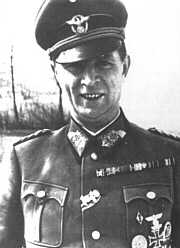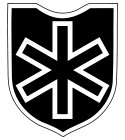Karl-Heinrich Brenner
| Karl Heinrich Brenner | |
|---|---|
 | |
| Born |
1 May 1895 Mannheim, Germany |
| Died |
February 14, 1954 (aged 58) Karlsruhe, Germany |
| Allegiance |
|
| Service/branch |
|
| Years of service |
1914–20 1939–45 |
| Rank | Gruppenführer and Generalleutnant of Polizei |
| Unit |
Field Artillery Regiment "von Scharnhorst" Baden Volunteer Battalion Ost 7th Infantry Regiment Police Regiment Warsaw SS Artillery Regiment Totenkopf SS Polezei Artillery Regiment 6th SS Gebirgs Division Nord |
| Battles/wars |
World War I World War II |
| Awards |
Knight's Cross of the Iron Cross German Cross in Gold |
Karl Heinrich Brenner (1 May 1895 — 14 February 1954) was a Leutnant in the Imperial German Army during World War I. He then joined the State police force before joining the Waffen SS. He rose to the rank of Gruppenführer and Generalleutnant of Polizei during World War II and was awarded the Knight's Cross of the Iron Cross to recognize extreme battlefield bravery and successful military leadership by Nazi Germany during World War II.
Early life
Karl Heinrich Brenner was born on 1 May 1895, in Mannheim. He attended a secondary technical school and after graduation volunteered to join the Imperial German Army on the 3 August 1914. He joined the Field Artillery Regiment "von Scharnhorst" in Hanover.
World War I
Brenner was selected to become an officer in 1915, and promoted to Leutnant, he remained in the Field Artillery Regiment "von Scharnhorst" until January 1919. He then served with the Baden Volunteer Battalion Ost from January 1919 to April 1920. During the war he was awarded the Iron Cross 1st and 2nd class and the Wound Badge in Silver, for being wounded four times.
Between the Wars
Brenner participated in the Kapp Putsch, the attempt to overthrow the Weimar Republic and was then discharged from the Army's 7th Infantry Regiment in 1920.
Brenner then joined the Landespolizei in Baden and in 1926, joined the Hitler Youth. In May 1933 he joined the NSDAP (party number 3.460.685). In 1935 he moved to the National Police School in Berlin and became an aide to the deputy commander of the Prussian State Police. He also got married to Ursula Moninger-Brenner (born March 26, 1915 – 1983, she would later marry Oberstgruppenführer, Sepp Dietrich in 1942). In the summer of 1935 he was involved with the Artillery exercises at the Jüterbog Artillery School with the 4th Artillery Regiment in Ulm. In 1936 he was promoted to Battalion Commander and Hauptmann of Ordnungspolizei and he joined the SS on the 11 September 1938 (SS number 307.786) and was given the rank of Obersturmbannführer.
He then participated in the Anschluss of Austria and the occupation of the Sudetenland in 1938. In August 1939, he was given command of the Police Sports School at Spandau in Berlin.
World War II
During World War II his first assignment was from October 1939 the command of the police regiment Warsaw until March 1940 when he was transferred to the SS Division Totenkopf and given temporary command of the SS Artillery Regiment Totenkopf.
After the Totenkopf Artillery Commander resumed command Brenner was given command of the SS Polizei Artillery Regiment. He received the Wound Badge in Gold in September 1941 for the loss of his left eye and in November 1941. He was posted to command the Waffen SS Northwest and became the inspector of the police at Salzburg. Then from August to October 1942, he assisted in the formation of the SS General Command.
In December 1942, he was given command over one of the four Kampfgruppes (battle groups), in the occupation of the French port of Toulon. In February 1943 he returned to Berlin as commander of the Central office of Ordnungspolizei and then commander of the Ordnungspolizei in Salzburg, as the Chief of anti-partisan operations under Higher SS and Police Leader Alpenland which was one of the most powerful postings in Nazi Germany. He also got married for the second time in 1942, leaving his first wife and three daughters.
During December 1943, he was posted as the police commander in the Ukraine and was also awarded the German Cross in Gold. The citation read: On 2 March 1944, Gruppenführer and Generalleutnant of Polizei Brenner with a small convoy of personnel carriers entered the town of Borki. He personally led the defensive fight, for three days ensuring the town could be held. On 15 March 1944 he met the enemy in the northern part of Kremianez and Gruppenführer Brenner personally led the last reserves in the counter-attack and forced the their superior opponents out of this part of the town. On 21 March 1944, the Russian forces had overwhelmed our lines in the vicinity of Dytkoviecki in a surprise Russian tank attack. Gruppenführer Brenner by his personal bravery, stopped our forces from retreating and built a new front line. On 27 March 1944 Russian tanks broke through the line in the Suchovola sector. Gruppenführer gathered the members of the divisional staff and launched a counterattack. On 2 April 1944 the German line south of Brody was broken by a superior force. Under the leadership of the Gruppenführer Brenner he gathered the scattered troops and started a counterattack, which stopped the Russian attack and over the night of the 5 and 6 April 1944 on height 261, southwest of Brody, he arranged several counterattacks which, resulted in the capture of the local supply route along a major road. On 13 and 14 April 1944, in the sector of Stanislavzik, Brody and Hutniki the Kampfgruppe was forced back after the shock of the Russian attack, Gruppenführer Brenner personally positioned the reserve troops and forced the superior attacking force back. This allowed the defence to be carried out as planned.
Karl Brenner next assumed command of the Curt von Gottberg Kampfgruppe in July 1944 and Chief of the Bandenkampfverbände (substituting for Erich von dem Bach-Zelewski) between July and September 1944 on anti partisan operations. He then replaced Gustav Lombard as commander of the 6th SS Gebirgs Division Nord in September 1944, It was while in command of the 6th SS Gebirgs Division that he was awarded the Knight's Cross in December 1944.
The Division was under command of the XVIII Mountain Corps and under attack by the advancing Russian forces in the Karella sector. They were ordered to breakthrough at Kuusamo, Kistinki and simultaneously to prevent reinforcements moving up. On 19 September 1944, the Division attacked a Regiment held in reserve that consisted of two mountain artillery battalions and Headquarters. The successful defence secured the front line along the Finnish, Russian border.
After pulling out of Finland the division was transferred to Denmark and later to Germany, where they surrendered to US forces in Bavaria. Brenner remained in command of the Division until 2 April 1945 when he was made a prisoner of war by the Americans.
Post war
Brenner survived the war in captivity upon his release he returned to Germany and died on the 14 February 1954 in Karlsruhe.
Decorations and awards
- Knight's Cross of the Iron Cross on 27 December 1944 as SS-Gruppenführer and Generalleutnant of the Waffen-SS and commander of the 6. SS-GebirgsDiv "Nord"[1][Note 1]
- German Cross in Gold
- Iron Cross 1st Class 1914 & 1939
- Iron Cross 2nd Class 1914 & 1939
- Wound Badge 1939 in Gold
- Wound Badge 1918 in Silver
- Infantry Assault Badge in Silver
- War Merit Cross 1st class and 2nd class, with Swords
- Anschluss Medal
- Sudetenland Medal
- The Honour Cross of the World War 1914/1918
- SS Long Service Award
- Order of the Zähringer Lion, Knight 2nd class with swords (Baden)
- Military Merit Cross (Prussia)
- Grand Duchy of Oldenburg, Friedrich August Cross 1st and 2nd class
- Duchy of Brunswick, War Merit Cross 1st and 2nd class
- Grand Duchy of Baden, Military Karl-Friedrich Merit Medal (Karl Friedrich-Militär-Verdienstmedaille)
- Prussian Military Merit Medal, 2nd class
- Honour Cross, 1st and 2nd class (Oldenburg)
- Austrian War Commemorative Medal with swords
- Bulgarian War Commemorative Medal with swords
- Hungarian War Commemorative Medal with swords
- German Sports Badge in Gold
- German Horseman Badge in Silver
- NSDAP Service Ribbon in Bronze
- SS-Ehrenring ("SS Honour Ring"), unofficially called Totenkopfring
- Julleuchter
- Sword of honour of the Reichsführer-SS
- Honour Chevron for the Old Guard
- Golden Hitler Youth Badge
- Golden Medal of Honour of HJ (No. 12,410 )
- Police Service Ribbon
- German Olympic Decoration, 2nd class
- Badges of the German Life Saving Association (Deutsche Lebens-Rettungs-Gesellschaft e.V.)
| Military offices | ||
|---|---|---|
| Preceded by SS-Brigadeführer Gustav Lombard |
Commander of 6th SS Mountain Division Nord September 1944 – March 1945 |
Succeeded by SS-Standartenführer Franz Schreiber |
Notes
References
- Citations
- Bibliography
- Fellgiebel, Walther-Peer (2000). Die Träger des Ritterkreuzes des Eisernen Kreuzes 1939–1945 – Die Inhaber der höchsten Auszeichnung des Zweiten Weltkrieges aller Wehrmachtteile [The Bearers of the Knight's Cross of the Iron Cross 1939–1945 — The Owners of the Highest Award of the Second World War of all Wehrmacht Branches] (in German). Friedberg, Germany: Podzun-Pallas. ISBN 978-3-7909-0284-6.
- Henschler Henri & Fay Will (2003). Armor Battles of the Waffen-SS, 1943-45. Stackpole Books. ISBN 0-8117-2905-2.
- Mitcham, Jr.Samuel (2007). Retreat to the Reich. Stackpole books. ISBN 0-8117-3384-X.
- Mitcham, Samuel (2007). The German Defeat in the East, 1944-45. Stackpole Books. ISBN 0-8117-3371-8.
- Scherzer, Veit (2007). Die Ritterkreuzträger 1939–1945 Die Inhaber des Ritterkreuzes des Eisernen Kreuzes 1939 von Heer, Luftwaffe, Kriegsmarine, Waffen-SS, Volkssturm sowie mit Deutschland verbündeter Streitkräfte nach den Unterlagen des Bundesarchives [The Knight's Cross Bearers 1939–1945 The Holders of the Knight's Cross of the Iron Cross 1939 by Army, Air Force, Navy, Waffen-SS, Volkssturm and Allied Forces with Germany According to the Documents of the Federal Archives] (in German). Jena, Germany: Scherzers Miltaer-Verlag. ISBN 978-3-938845-17-2.
| ||||||||||||||||||||||||
|
